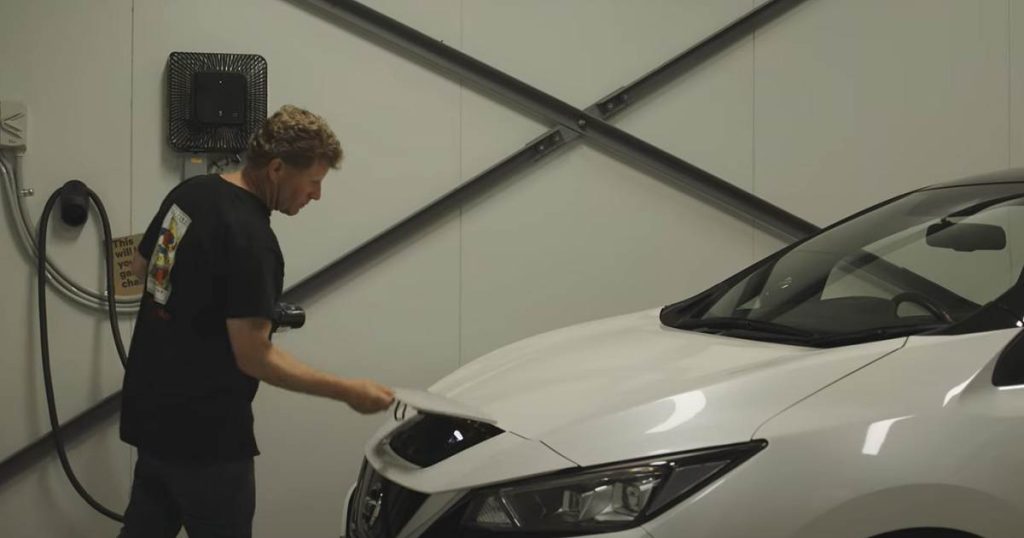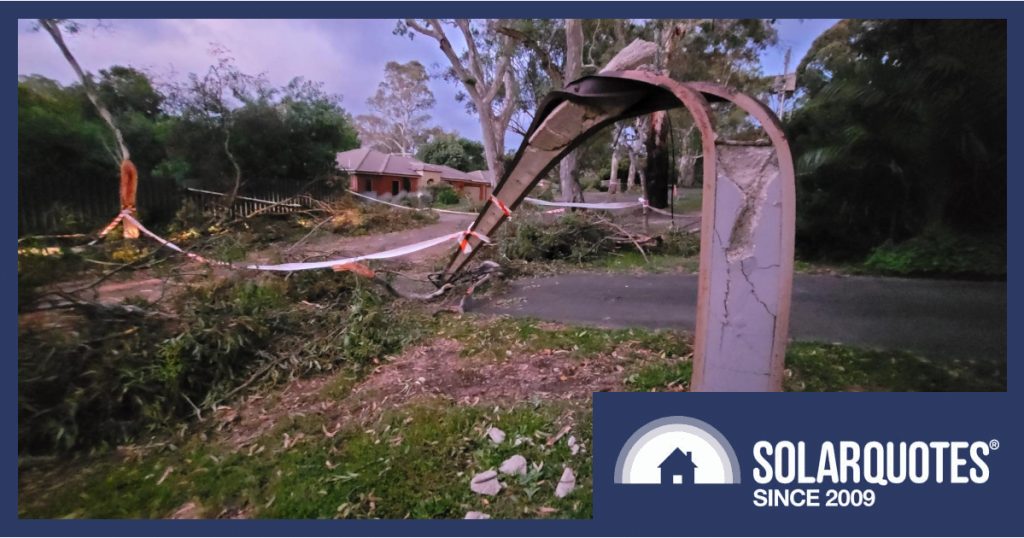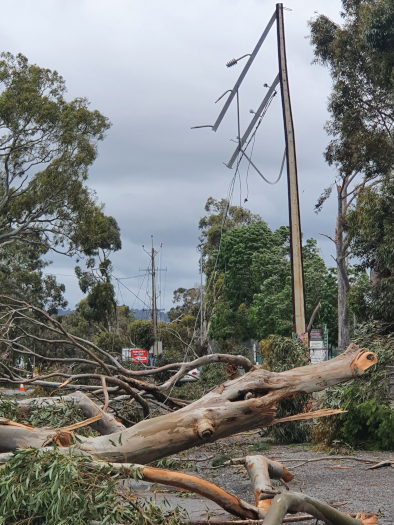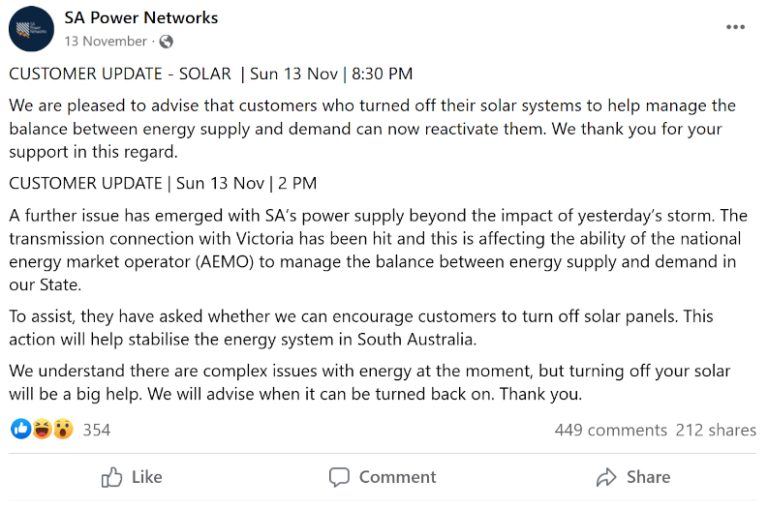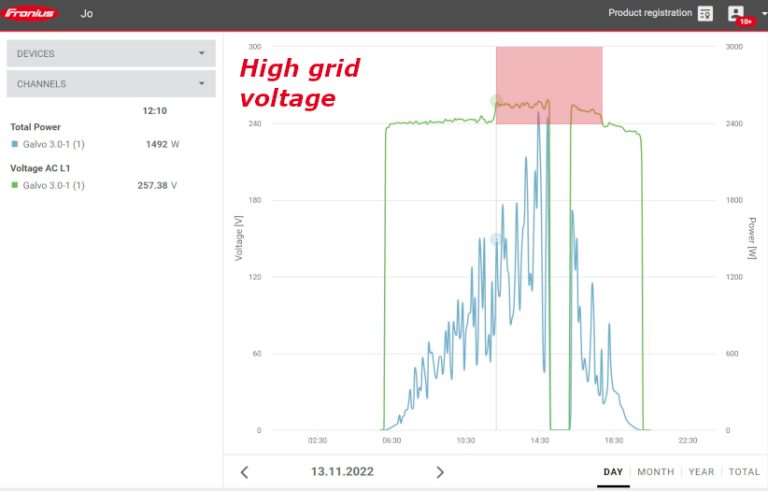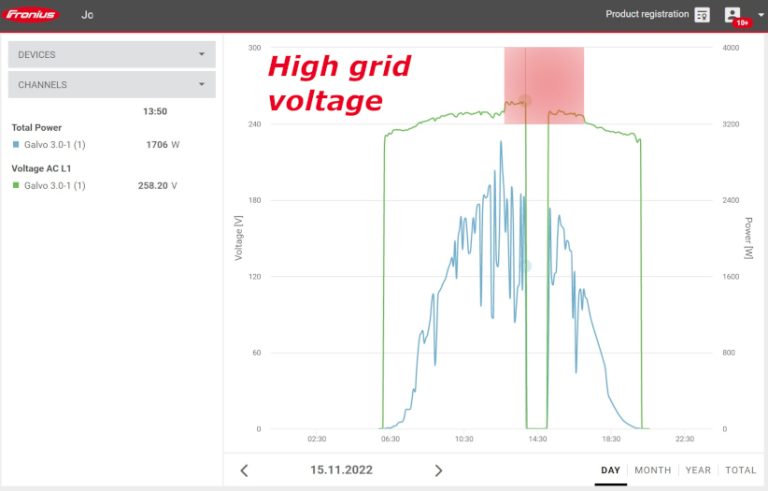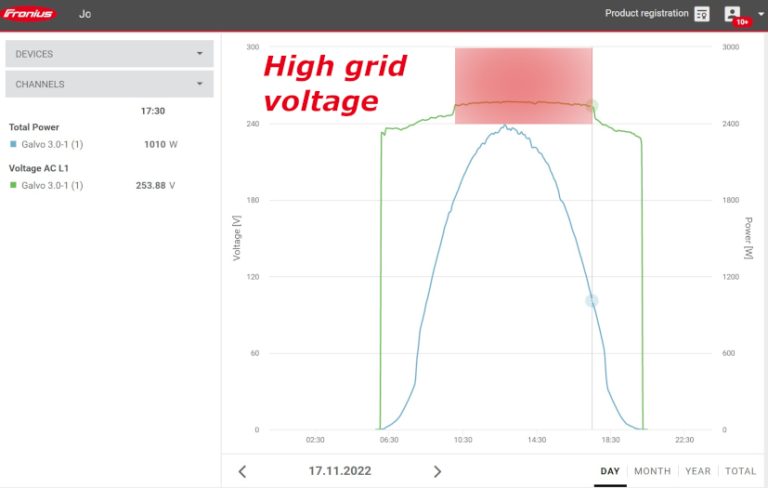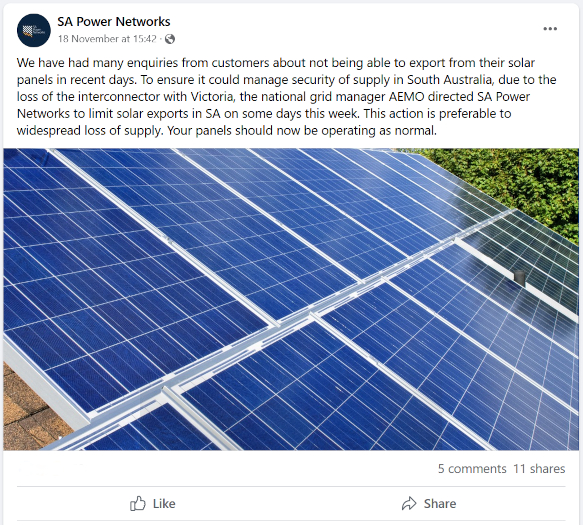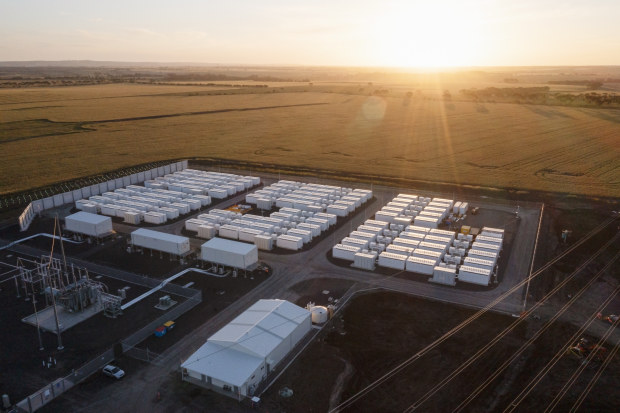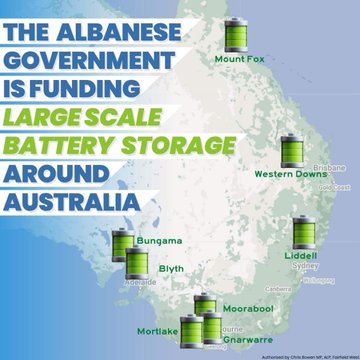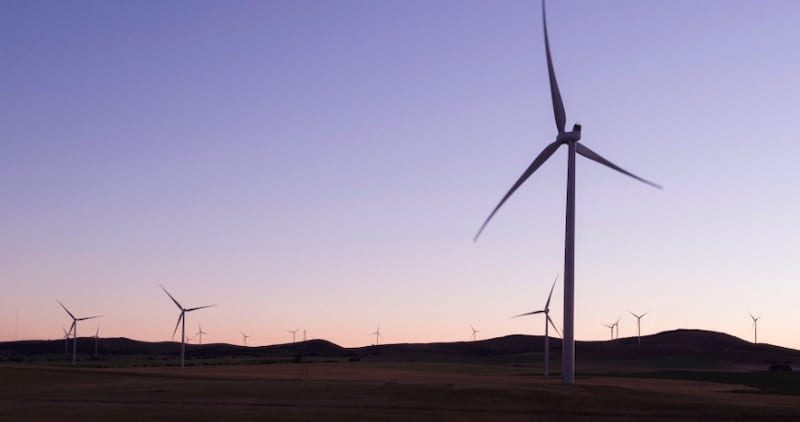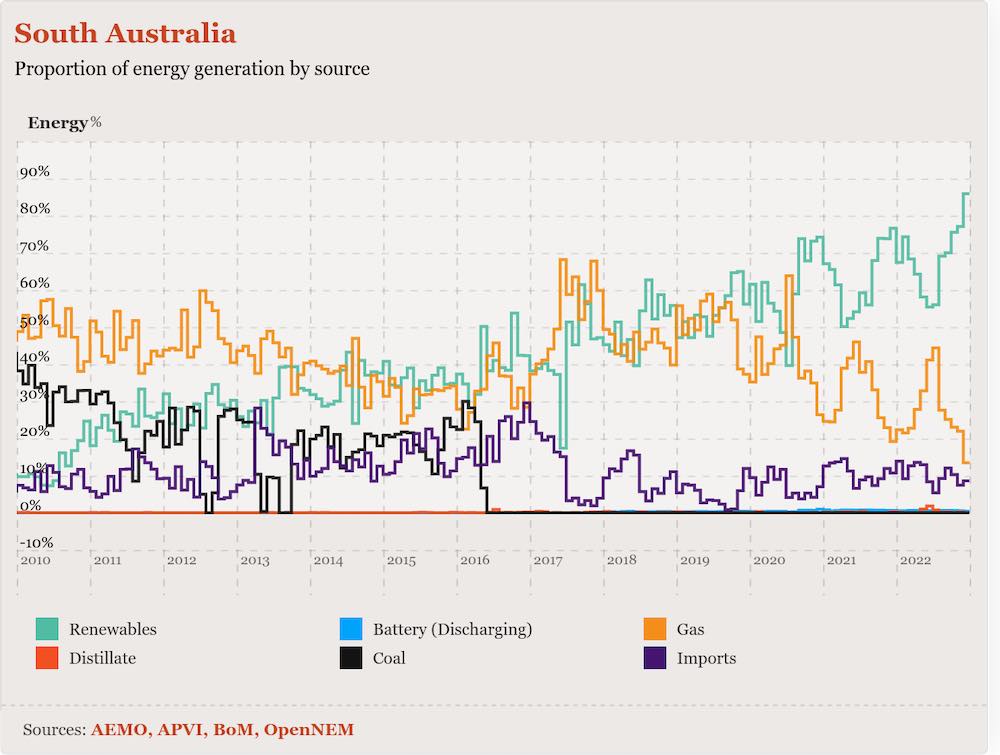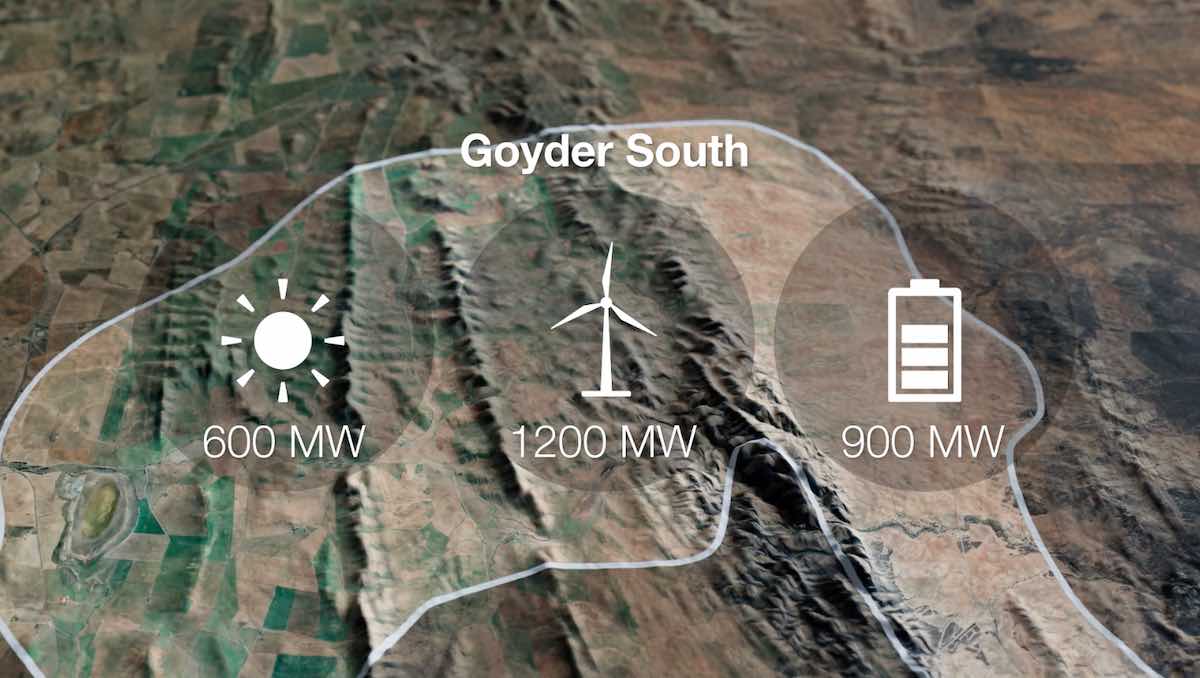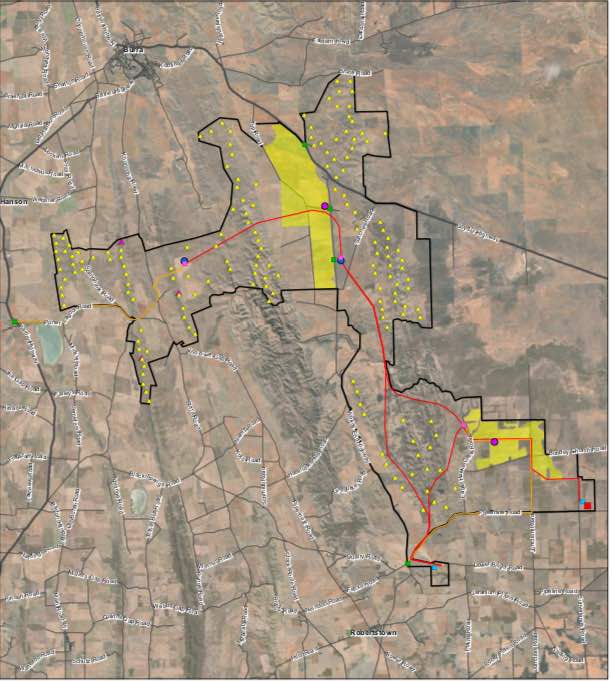It is much easier to convert a factory powered by electricity made from coal to one powered by electricity made from wind than it is to convert a brick kiln heated directly by gas to one heated by electricity. I can't just connect a wind turbine to the gas pipe.
News & Discussion: Electricity Infrastructure
Re: News & Discussion: Electricity Infrastructure
Re: News & Discussion: Electricity Infrastructure
Since I posted that, I read that CWP Renewables was bought by Andrew Forrest a couple of weeks ago from a Swiss-based private equity company, so another large renewable generation portfolio is back in Australian ownership.SBD wrote: ↑Thu Dec 22, 2022 12:02 am"Foreign owned" also means "foreign investment".rev wrote: ↑Wed Dec 21, 2022 5:34 pmIran, Saudi Arabia have the cheapest petrol in the world.
They are also some of the biggest producers of oil.
Australia is one of the biggest gas producers, but we pay a premium thats ever increasing, while China and Japan enjoy our gas at a lower cost then it does us.
But sure, renewables will fix it all.
Foreign owned renewables.
Cost hasn't come down, its gone up. Despite the countless promises more renewables will bring costs down.
I wonder which party will have the more believable promise to reduce costs at the next election.
"Tilt Renewables is part of Powering Australian Renewables (PowAR) – a partnership between QIC, the Future Fund and AGL Energy Ltd." As far as I can tell, all three partners are Australian. Palisade Investment Partners also appears to be Australian.
Why do you think most wind farms and other renewable energy generators in Australia are owned by foreign investors? What can or should be done to encourage more domestic investment (assuming that would be "good")?
Re: News & Discussion: Electricity Infrastructure
"Foreign owned" also means "foreign investment".SBD wrote: ↑Thu Dec 22, 2022 10:42 pm[quote=SBD post_id=208286 time=<a href="tel:1671629543">1671629543</a> user_id=6279]
[quote=rev post_id=208278 time=<a href="tel:1671606271">1671606271</a> user_id=357]
Iran, Saudi Arabia have the cheapest petrol in the world.
They are also some of the biggest producers of oil.
Australia is one of the biggest gas producers, but we pay a premium thats ever increasing, while China and Japan enjoy our gas at a lower cost then it does us.
But sure, renewables will fix it all.
Foreign owned renewables.
Cost hasn't come down, its gone up. Despite the countless promises more renewables will bring costs down.
I wonder which party will have the more believable promise to reduce costs at the next election.
"Tilt Renewables is part of Powering Australian Renewables (PowAR) – a partnership between QIC, the Future Fund and AGL Energy Ltd." As far as I can tell, all three partners are Australian. Palisade Investment Partners also appears to be Australian.
Why do you think most wind farms and other renewable energy generators in Australia are owned by foreign investors? What can or should be done to encourage more domestic investment (assuming that would be "good")?
[/quote]
Since I posted that, I read that CWP Renewables was bought by Andrew Forrest a couple of weeks ago from a Swiss-based private equity company, so another large renewable generation portfolio is back in Australian ownership.
[/quote]
You do realise that Andrew Forrest’s Future Industries is based entirely on a funding model that relies on subsidy mining. Ie your taxpayer dollars and energy bills- all making him very rich. Meanwhile his iron ore is shipped to China, where they make finished steel products, using coal fired power generation from Australian coal. You get it yet??? We are exporting our emissions. But hey, we look like we are doing our part at the UN now.
Re: News & Discussion: Electricity Infrastructure
South Australian legislation changed so that electric cars will be able "to export" power to your home...to the grid.
From Solar Quotes
From Solar Quotes
Electric Vehicles: V2G Good To Go In South Australia
EV owners in South Australia can reportedly now apply to SA Power Networks to install V2G bi-directional chargers. While an important step towards making better use of electric cars, don’t get too excited just yet.
Electric cars can do much more than just transport us from point A to B. An EV can also be used to power appliances, homes and deliver grid services. But not all electric vehicles currently available have these capabilities, and their capabilities vary.
There are three technologies involved. Very briefly:
V2L – Vehicle To Load (sometimes referred to as VTOL). Supports plugging external loads into the vehicle.
V2H – Vehicle To Home. Allows the use of an EV as a (really big) home battery system.
V2G – Vehicle To Grid. Specifically describes the ability for an electric car to discharge to the grid; but increasingly, to also power a home.
SolarQuotes has more detailed information on V2L, V2H and V2G here.
V2H and V2G require not only an electric car capable of supporting these technologies, but also a compatible bi-directional charger. Unlike a standard EV charger that only works one-way, a bi-directional charger operates from the charging source to the EV and from the EV to the grid and/or home. As such, there need to be specific standards, rules and regulations in place around their use.
SA Leading The Way On V2G
Discussion on national standards for bi-directional chargers is expected to kick off early next year. But according to Nissan, South Australians can now apply (via their installer) to SA Power Networks (SAPN) to get permission to install one of the beasties.
Nissan’s announcement refers to a specific bi-directional charger, the Wallbox Quasar. It’s going to be a pricey bit of kit initially – I’ve seen figures bandied about ranging from $10,000 – $14,000.
Nissan says JET Charge will be taking orders from South Australian customers starting late January. With regard to hard-wired EV chargers generally, SAPN states a charger needs to be purchased first before an application for approval for connection can be made.
Nissan’s pretty pumped about all this as the Wallbox Quasar is compatible with the Nissan Leaf.
“V2G transforms the Nissan LEAF from a vehicle into a mobile energy storage solution, at once meeting both your transport and home energy needs,” said the company’s National Manager of Electrification and Mobility, Ben Warren. “We’ve seen this technology deployed internationally, and it’s so exciting to now see it begin rolling out across Australia, first in the ACT with the REVS project, and now with our first customer site in SA.”
V2G A “No-Brainer”
The first customer site in South Australia is at Ballycroft Vineyard and Cellars in the Barossa Valley.
According to Ballycroft owner Joseph Evans, he’s gone from forking out $6,000 annually for electricity to a zero bill – and making around $50 per week selling surplus power back to the grid. The large solar power system initially installed at the winery knocked $4,000 off his annual electricity costs. The combination of Nissan Leaf (40 kWh battery) and Wallbox Quasar took care of the rest; plus his set-up provides a bit of drinking silver to boot.
“It makes me entirely self-sufficient with my power needs, makes my home and business more sustainable, and it’s so easy to use,” said Mr. Evans
Mr. Evans says the Nissan Leaf starts its day fully charged and is used to deliver wine to Adelaide daily. The EV is back at Ballycroft by midday, charging from the rooftop solar power system until around 6pm. Then from 6pm to 6am, the car is switched to discharge to power his house.
https://youtu.be/8JbbsvGBYRc
Given the vehicle starts its transport working day fully charged as Mr. Evans mentions, this could mean some mains grid power is involved. But since he has such a large solar power system (33kW), Nissan says the battery is topped up in the morning with solar electricity. No doubt the charging/discharging schedule and source vary with seasonal and weather conditions.
UPDATE 5:30 PM: Unknown to me until this afternoon, SolarQuotes founder Finn had already been out to Ballycroft to chat with Joseph about his V2G setup. In this SQ video just released, Joseph talks to Finn in-depth about how much it all cost, tech specs, clarifies how he’s using the Leaf’s battery at night (it differs somewhat to what is stated above), warranty implications – and a couple of surprising limitations.
The Only V2G EV Show In Town
As the video indicates, Mr. Evans is more than a little convinced about the potential for V2G.
“If your next car is going to be an EV, and it should be, make sure it has Vehicle-To-Grid technology, like the Nissan LEAF,” says Mr. Evans.
At this point in time in Australia, such an EV wouldn’t just need to be like a Leaf, it would have to be one. It’s the only V2G compatible *fully electric* car available here at the moment. The Wallbox Quasar may be the only bi-directional charger available here for it too. The Quasar’s compatibility with other electric vehicles is also very limited (CHAdeMO connector); although the new Wallbox Quasar 2 (CCS) will offer much broader EV compatibility.
But still, exciting times ahead for electric vehicles in Australia. Prices of bi-directional chargers will drop as they become more widely available, and perhaps in the not-too-distant future we’ll see some households that may have otherwise bought a home battery system opt for an EV with V2G/V2H capabilities instead. Kilowatt-hour for kilowatt-hour capacity, it could work out cheaper than some home batteries; including Tesla Powerwall.
And a Powerwall won’t take you to the shop.
https://www.solarquotes.com.au/blog/ev-v2g-sa-mb2764/
Re: News & Discussion: Electricity Infrastructure
It will be problematic if you get up in the morning, and instead of being charged, the car has discharged into the grid overnight and hasn't yet had a chance to recharge from the sun.
Whether this is feasible will depend on how much power you use overnight, which season it is, and what time in the morning you need to use the car to drive to work or school.
In summer, the sun is up early and might be able to recharge the car enough for the morning trip, but in winter the sun won't have come up and recharged the car's battery much if at all.
Whether this is feasible will depend on how much power you use overnight, which season it is, and what time in the morning you need to use the car to drive to work or school.
In summer, the sun is up early and might be able to recharge the car enough for the morning trip, but in winter the sun won't have come up and recharged the car's battery much if at all.
Re: News & Discussion: Electricity Infrastructure
With a standard home AC EV charger it would take something like 8 hours to completely discharge a mostly full battery back into the grid, plus any sane V2G system is going to have built in safeguards so users can set discharge limits. That said, accidentally discharging your car battery is a risk many people are probably unwilling to take considering there's not going to be much reward (maybe a dollar or two from feed in tariff per day) so I think V2G will mostly be a niche application in typical private home usage. I can see it being used by commercial or govt. fleet operators though - if you have 100 vans returning to garages in the late afternoon every day, you may as well put those assets to a bit of use while they are idle.ralmin wrote: ↑Fri Dec 30, 2022 8:27 pmIt will be problematic if you get up in the morning, and instead of being charged, the car has discharged into the grid overnight and hasn't yet had a chance to recharge from the sun.
Whether this is feasible will depend on how much power you use overnight, which season it is, and what time in the morning you need to use the car to drive to work or school.
In summer, the sun is up early and might be able to recharge the car enough for the morning trip, but in winter the sun won't have come up and recharged the car's battery much if at all.
-
rubberman
- Super Size Scraper Poster!
- Posts: 1758
- Joined: Tue Sep 04, 2007 10:32 pm
- Location: ADL ex DRW, ASP, MGB
Re: News & Discussion: Electricity Infrastructure
While that's true, you'd have to make a mistake in the software settings for it to happen. No doubt, being human, plenty of people will do it occasionally.ralmin wrote: ↑Fri Dec 30, 2022 8:27 pmIt will be problematic if you get up in the morning, and instead of being charged, the car has discharged into the grid overnight and hasn't yet had a chance to recharge from the sun.
Whether this is feasible will depend on how much power you use overnight, which season it is, and what time in the morning you need to use the car to drive to work or school.
In summer, the sun is up early and might be able to recharge the car enough for the morning trip, but in winter the sun won't have come up and recharged the car's battery much if at all.
However, the internal combustion engine equivalent is a mistake like leaving the lights on overnight and needing to call the RAA next morning.
So, just like leaving the lights on overnight on a fossil fuel car is a mistake you'll make sometimes, having the wrong software setting and ending up with a low battery in an EV is the same. Not a big deal in the scheme of things.
Re: News & Discussion: Electricity Infrastructure
Article dealing with home solar curtailment/gid changes since the blackout of 2016.
From Solar Quotes
From Solar Quotes
South Australia Proves You Can Go Off-Grid With A Million People
In November 2022, South Australia experienced a ferocious storm that decoupled us from the rest of the electricity grid and felled many local power lines. Functioning as an island, we couldn’t export to the bigger national network, so without that safety valve, SA Power Networks (SAPN) was obliged to pull out all the stops to maintain stability.
They used a pretty blunt instrument. By running the network controls at some substations up to 260 volts, all the solar systems (properly) installed since 2015 tripped off in those areas.
Despite breaking national electricity rules around maximum supply voltage, the blunt instrument worked well. SAPN broke a few eggs to ensure we could all still cook omelettes. I’d argue that’s much better than giving the noisy regressives any reason to clutch their pearls about rolling blackouts1.
I remember when troglodytes claimed more than 5 or 10% renewables would cause the wires to melt and the sky to fall.
In reality, SA has generated over 70% variable renewable energy for 12 months, and the lights are still on. Unfortunately, good news doesn’t sell copies of The Awfultiser.
Australia Learned From SA’s 2016 Big Blackout
In retrospect, the 2016 system black was probably a blessing. The electricity industry has learnt a great deal. Large-scale generators updated their procedures to be more resilient, and small-scale generators benefited from resulting updates to the Australian Standard for solar inverters: AS 4777.2. That standard was updated in 2020 along with SAPN connection requirements to make our renewables-heavy grid more robust.
While the spot market is bought and sold in 5-minute intervals, grid electricity cycles 50 times per second. It must be kept stable from one fraction of a second to the next. Traditionally this has been done by running the generators, literal tons of metal, in large steam-powered plants at 3000 revolutions per minute.
The inertia in these machines provides what the industry calls Frequency Control And Ancilliary Services (FCAS). This system inertia holds frequency within a couple of points of 50 Hz. This is important to keep the pump in your coffee machine happy and make the clock on your oven hold time.
Synchronous Condensers Installed
The modern grid in SA now has these tons of metal in smaller lump. Some are conventional generators like those at Pelican Point Power Station, but the most recent are four synchronous condensers (AKA syncons) installed at three different points on the network. Now they’re installed, AEMO allows the system to run with just 80 MW of conventional gas-fired inertia, (down from 300 MW). Wind farms and big batteries are now permitted to enter the FCAS market too.
When the 2016 system black occurred, wind was doing half the work, and the Heywood interconnect from Victoria was doing another 30%.
As the towers fell and lines short-circuited, the disturbances caused wind farms to disconnect. Their settings were too fussy, and they jumped off to protect themselves, leaving the network no option but to overload the interconnector, which threw the towel in 7 seconds later. Our gas generation fleet was perfectly capable, but they were mainly stone cold, offline or out for maintenance.
So, the settings have been changed, and now wind and solar power are obliged to hang on longer and generally be more flexible in emergencies. They will ride through disturbances and recover wherever possible, something a battery-backed inverter is the best at. Tons of spinning metal just isn’t as fast and accurate.
New Solar Inverter Standards For A New Grid
Since forever, the grid has worked as a hub and spoke network. The big thermal plants in the middle spinning power out to the extremities with fairly predictable losses cascading down through the whole system.
Now that we have democratised electricity, with millions of little solar generators pushing back from the bottom, there can be times when there’s too much energy. Left unchecked, the voltage and frequency would climb, driving the generators into overspeed and blowing up other things along the way.
The Smarter Solution: Dynamic Export Control
To combat this, SAPN has launched new requirements for new connections so they can, (via third-party agents and an internet connection) assume control in limited circumstances. Initially, this is a matter of putting out what I call the bat signal, a notice which causes large solar farms and many smaller systems to shut down or limit output to zero export.
The next step will be dynamic control, where your solar export limit will be higher (up to 10 kW) but dynamically throttled by the network when necessary. Dynamic exports have been successfully trialled, with broad adoption starting in July 2023.
Forced Shutdowns Via High Voltages Still Required
Although all new rooftop solar systems will have the necessary controls to switch off in grid emergencies, we’ll still need the aforementioned blunt instrument of forced local voltage rises for the foreseeable future – to deal with all the systems installed between 2015 (when the voltage-cut-off standard became law) and now.
By kicking lots of solar systems off the network, there is a compound effect. Getting rid of the excess generation means they can simply burn gas in conventional plants, which offer conventional control (plus conventional gas profits too no doubt?). The secondary benefit is it creates more load because solar customers become consumers again.
Now, this rubs some people up the wrong way, but it’s a measure of the idea that we’re all in this together. Solar customers take a small hit, voluntarily in many cases, to help keep the lights on for everyone.
How To Insulate Yourself From Forced Solar Switch-Offs
If you spend a good deal of money on a very particular off-grid style solar and battery system, you can island yourself from the network and continue to run on your own solar.
I recommend the Selectronic SP Pro, but it’s an expensive way to assume full control. Most grid hybrid systems will not disconnect when the grid voltage goes too high: they’re programmed to stop generating and standby until either the grid disappears altogether, in which case they operate under “blackout protection mode” or resume operation once the utility supply returns back to normal.
New Solar Standards Good, But Could Be Better.
The new solar standards have had interesting effects. The more onerous compliance issues have begun to drive some of the blowflies out of the solar industry, which can only be a good thing. Customer WiFi connectivity and commissioning issues have become the bane of many electricians’ existence, so the less able are just going back to ceiling fans and air conditioners.
Personally, I think there could be improvements to make the data connections we are now relying on more robust and easier to install. For example, Victoria uses meshed networks of smart meters that even include street lights. It’s not much of a leap to realise solar and electric car charging need to be managed, maybe air conditioning and pool pumps too.
It is great to see that the system has worked despite some enormous challenges. South Australia is arguably at the bleeding edge of the world’s energy transition, running a gigawatt scale grid on ever larger shares of renewable energy for longer and longer periods. Things are genuinely looking up and what we need now is much more long-duration storage, and electrification of transport, which will reduce gas use further.
Legacy solar systems shutting down for a few hours per year after severe storms is a small price to pay. After all – whether it’s an individual house or an entire state – when you go off-grid, you have to make a few compromises until the grid connection comes back online2.
Footnotes
Lots of people went without power for days – but that was due to downed power lines – nothing to do with renewables or rolling blackouts ↩
Yes – if you spend enough money on your off-grid system, you can go off-grid without compromise. For the rest of us – we have to watch our power and energy use ↩
https://www.solarquotes.com.au/blog/sa- ... enewables/
Re: News & Discussion: Electricity Infrastructure
Blyth battery is go !
From The Australian Financial Review
From The Australian Financial Review
Neoen starts building its fifth big battery in Australia
French clean energy producer Neoen has started the construction of its fifth grid-scale battery in Australia – a project in South Australia that will provide backup power for BHP’s Olympic Dam mine.
The Blyth project in the state’s mid-north will be able to run for two hours at its maximum output of 200 megawatts.
Neoen’s storage portfolio includes the 300MW Victorian “big battery” near Geelong.
It will be used to provide “renewable energy baseload” power to BHP, supplying electricity to the mine site when Neoen’s Goyder South wind farm is not generating enough, as per a contract signed between the pair in early November.
Neoen, whose Hornsdale battery project in South Australia was the first grid-scale storage project in the country, has since also installed the “Victoria Big Battery” in Geelong, and is building the Capital battery in the ACT and the Western Downs battery in Queensland.
The French company’s head in Australia, Louis de Sambucy, has voiced ambitions to install battery storage in all the states where Neoen operates, including NSW.
He said on Thursday that the Blyth project would bring Neoen’s total Australian assets – either in operation or construction – to almost 3 gigawatts.
Neoen did not reveal the cost of the Blyth battery, which is being partly funded by the Australian Renewable Energy Agency (ARENA) under its large-scale battery storage funding program. It will use so-called “grid-forming inverter technology”, which allows it to provide stability services to the power system. Traditionally, these have been provided by “synchronous” generators such as coal and gas power plants.
ARENA chief executive Darren Miller pointed to the essential role battery storage would play in the transition of the electricity supply system, allowing generation from weather-dependent wind and solar plants to be smoothed out and stored for when it is needed.
Neoen’s Blyth and Western Downs batteries were among eight storage projects selected by ARENA in December to share $176 million in funding. Each of the lithium-ion batteries will include advanced inverters, and the program is intended to break down barriers that prevent large-scale batteries from incorporating such technology.
The inverters convert electricity from direct current from batteries to alternating current that is delivered to homes and businesses. While most grid-scale batteries have “grid-following” inverters that tend to be unstable when installed in a weak grid and do not inherently contribute to the strength of the power system, “grid-forming” inverters support the stability of voltage in the system, according to ARENA.
https://www.afr.com/companies/energy/ne ... 105-p5camb
- 1NEEDS2POST
- High Rise Poster!
- Posts: 471
- Joined: Tue Jun 26, 2018 5:01 pm
Re: News & Discussion: Electricity Infrastructure
Here is a map of the western extremity of the network and here are the options: 1. Bottom left is Port Lincoln and I'm guessing that most of its capacity is used.SBD wrote: ↑Tue Dec 20, 2022 5:26 pmI'd like to see a large solar farm on marginal land near the western extremity of the network to help with the summer afternoon peak. That would likely need several substation upgrades as the power would flow in the opposite direction, but the farm could be scaled to only produce what the transmission line can handle.
2. Middle left is Wudinna, I have no idea why it was built, can anyone clarify? Is there a lower voltage line extending to Ceduna? I'm guessing it's low capacity to begin with.
3. Top left is Olympic Dam and I'm guessing that most of its capacity is used.
4. Top is Leigh Creek and it's now mostly disused. It provided power to the coal mine for the Playford power station. This seems like a good site for a solar power station since it's in arid land with plenty of insolation. Also, the solar panels can be placed on the top of mountains in the Flinders Ranges since the sun rises earlier and sets later the higher you go.
Could be solved with a hybrid V2G car (although not green).ralmin wrote: ↑Fri Dec 30, 2022 8:27 pmIt will be problematic if you get up in the morning, and instead of being charged, the car has discharged into the grid overnight and hasn't yet had a chance to recharge from the sun.
Whether this is feasible will depend on how much power you use overnight, which season it is, and what time in the morning you need to use the car to drive to work or school.
In summer, the sun is up early and might be able to recharge the car enough for the morning trip, but in winter the sun won't have come up and recharged the car's battery much if at all.
Re: News & Discussion: Electricity Infrastructure
I was thinking near Wudinna. As far as I can tell, that is the western end of the Electranet transmission network. Further west would be 66kV SA Power Networks. The line to Wudinna is 132kV single circuit from Yadnarie substation (west of Cleve), which has recently been upgraded to have double 132kV circuits to/from Whyalla.1NEEDS2POST wrote: ↑Sun Jan 08, 2023 8:43 pmHere is a map of the western extremity of the network and here are the options:SBD wrote: ↑Tue Dec 20, 2022 5:26 pmI'd like to see a large solar farm on marginal land near the western extremity of the network to help with the summer afternoon peak. That would likely need several substation upgrades as the power would flow in the opposite direction, but the farm could be scaled to only produce what the transmission line can handle.
Grid.png
1. Bottom left is Port Lincoln and I'm guessing that most of its capacity is used.
2. Middle left is Wudinna, I have no idea why it was built, can anyone clarify? Is there a lower voltage line extending to Ceduna? I'm guessing it's low capacity to begin with.
3. Top left is Olympic Dam and I'm guessing that most of its capacity is used.
4. Top is Leigh Creek and it's now mostly disused. It provided power to the coal mine for the Playford power station. This seems like a good site for a solar power station since it's in arid land with plenty of insolation. Also, the solar panels can be placed on the top of mountains in the Flinders Ranges since the sun rises earlier and sets later the higher you go.
Could be solved with a hybrid V2G car (although not green).ralmin wrote: ↑Fri Dec 30, 2022 8:27 pmIt will be problematic if you get up in the morning, and instead of being charged, the car has discharged into the grid overnight and hasn't yet had a chance to recharge from the sun.
Whether this is feasible will depend on how much power you use overnight, which season it is, and what time in the morning you need to use the car to drive to work or school.
In summer, the sun is up early and might be able to recharge the car enough for the morning trip, but in winter the sun won't have come up and recharged the car's battery much if at all.
I haven't found the capacity (MW) of the lines, but I'd imagine that a solar farm north of Wudinna could connect there, and be scaled so that on a sunny day, the west coast operates on solar power and the line runs at capacity feeding solar power back to the east of the state. I expect that requires some fancy frequency management at the substations to reverse the flow of the current, but it must be possible on the interstate connectors, and possibly is already on the Port Lincoln circuit due to the wind farms and power station.
A "big battery" there might mean that for much of the year, the current only needs to flow east, with the battery powering the west coast distribution network overnight.
Re: News & Discussion: Electricity Infrastructure
South Australia reached 85% renewables in December 2022 (85% of all power produced came from solar and wind)
South Australia hits stunning new high in race to renewables-only grid
South Australia continues its record-breaking run on renewables, with wind and solar contributing just over 85% (85.4%) of the state’s electricity demand for the month of December.
University of New South Wales energy system analyst Dylan McConnell says this is “comfortably a new monthly record” for South Australia, surpassing the state’s previous record of 76%, set in December 2021.
McConnell says renewable energy also contributed almost 80% of South Australia’s demand for the whole quarter (79.2%), making it the highest quarter on record, too.
South Australia – already leading the world with its share of wind and solar – is poised to become the first grid of its size to operate without synchronous generation within the next few years, according to the Australian Energy Market Operator (AEMO).
And it’s December record is hardly surprising, considering the state’s world-first a run of more than 10 consecutive days in that month when the average production of wind and solar accounted for 100 per cent of local demand.
s RenewEconomy reported at the time, no other gigawatt scale grid in the world has come close to this amount of “variable renewable energy”, or for such a long time.
McConnell, then, put South Australia’s December stretch of more than 100 per cent renewables at 10 days, 18 hours and 45 minutes, with the mean price over that period averaging minus $3.26/MWh.
Over that period, data shows rooftop solar contributed a massive 26.3 per cent – and dominated daytime production, sometimes up to 92 per cent of local demand.
The biggest contribution, however, came from wind energy, with a 67.6 per cent share over that time, while large scale solar – heavily curtailed because of negative prices and the impact of rooftop PV – contributed just 6.1 per cent.
https://reneweconomy.com.au/south-austr ... only-grid/
And Adelaide to host the 2024 International Renewable Conference
https://reneweconomy.com.au/south-austr ... onference/
- 1NEEDS2POST
- High Rise Poster!
- Posts: 471
- Joined: Tue Jun 26, 2018 5:01 pm
Re: News & Discussion: Electricity Infrastructure
If you're building it in the west because the sun sets later, it's not going to make a difference at these distances. Wudinna to Adelaide is only three degrees of longitude. Given the Earth rotates 15 degrees per hour relative to the sun, the difference in power generating period is 12 minutes behind us.SBD wrote: ↑Sun Jan 08, 2023 10:19 pmI was thinking near Wudinna. As far as I can tell, that is the western end of the Electranet transmission network. Further west would be 66kV SA Power Networks. The line to Wudinna is 132kV single circuit from Yadnarie substation (west of Cleve), which has recently been upgraded to have double 132kV circuits to/from Whyalla.
I haven't found the capacity (MW) of the lines, but I'd imagine that a solar farm north of Wudinna could connect there, and be scaled so that on a sunny day, the west coast operates on solar power and the line runs at capacity feeding solar power back to the east of the state. I expect that requires some fancy frequency management at the substations to reverse the flow of the current, but it must be possible on the interstate connectors, and possibly is already on the Port Lincoln circuit due to the wind farms and power station.
A "big battery" there might mean that for much of the year, the current only needs to flow east, with the battery powering the west coast distribution network overnight.
Ceduna to Adelaide is five degrees, so 20 minutes behind.
Perth to Adelaide is 23 degrees, so one hour 32 minutes behind.
Perth to Brisbane is 38 degrees, so two hours 32 minutes behind.
The Eyre Peninsula has a different climate and will be cloudy at different times, so it's still worthwhile expanding out there for this diversity, especially with wind. The real benefits to building west for the later setting sun will come when WA is connected to the grid.
Re: News & Discussion: Electricity Infrastructure
I suspect that even 12 minutes (maybe 11 from Port Augusta, 14 from Tailem Bend) would make a difference as the peak demand is much more around sunset than sunrise. I haven't checked, but I also suspect that rooftop/small solar is also geographically skewed to the (south-)east of the state. Once the new interconnector is built, that 12 minutes can also be added to the time difference all the way over to Sydney.1NEEDS2POST wrote: ↑Tue Jan 31, 2023 10:06 pmIf you're building it in the west because the sun sets later, it's not going to make a difference at these distances. Wudinna to Adelaide is only three degrees of longitude. Given the Earth rotates 15 degrees per hour relative to the sun, the difference in power generating period is 12 minutes behind us.SBD wrote: ↑Sun Jan 08, 2023 10:19 pmI was thinking near Wudinna. As far as I can tell, that is the western end of the Electranet transmission network. Further west would be 66kV SA Power Networks. The line to Wudinna is 132kV single circuit from Yadnarie substation (west of Cleve), which has recently been upgraded to have double 132kV circuits to/from Whyalla.
I haven't found the capacity (MW) of the lines, but I'd imagine that a solar farm north of Wudinna could connect there, and be scaled so that on a sunny day, the west coast operates on solar power and the line runs at capacity feeding solar power back to the east of the state. I expect that requires some fancy frequency management at the substations to reverse the flow of the current, but it must be possible on the interstate connectors, and possibly is already on the Port Lincoln circuit due to the wind farms and power station.
A "big battery" there might mean that for much of the year, the current only needs to flow east, with the battery powering the west coast distribution network overnight.
Ceduna to Adelaide is five degrees, so 20 minutes behind.
Perth to Adelaide is 23 degrees, so one hour 32 minutes behind.
Perth to Brisbane is 38 degrees, so two hours 32 minutes behind.
The Eyre Peninsula has a different climate and will be cloudy at different times, so it's still worthwhile expanding out there for this diversity, especially with wind. The real benefits to building west for the later setting sun will come when WA is connected to the grid.
Most of the generation capacity is not needed most of the time. The critical point is the few days or hours of highest demand. If a bit more direct generation can delay the drain on the batteries by 12 minutes, that might be enough.
Re: News & Discussion: Electricity Infrastructure
Neoen are going to build a new transmission line to transfer power around their Goyder South site.
From Renew Economy
From Renew Economy
Neoen gets transmission go-ahead for first stage of country’s biggest renewable zone
Neoen has convinced South Australian energy bureaucrats that the 33km long transmission line it must build to get power from what will be the country’s biggest renewable energy zone to the people shouldn’t be regulated.
Months after signing a deal to initially connect 209 megawatt (MW) of the first 412 MW wind stage of the Goyder South project, the state’s Essential Services Commission exempted Neoen from holding a licence for the transmission line.
Normally companies building transmission lines need to get a licence to operate, but Neoen has escaped that requirement on the grounds that its 33km, 275kV transmission line will be used solely to connect the separate wind generation facilities to ElectraNet’s Robertstown substation and not send power to customers.
The company expects to sign a deal to cover the rest of the planned capacity of the wind farm soon.
Neoen locked in financing for the initial 209 MW stages last month, with long term power purchase agreements with the ACT government, BHP for its Olympic Dam mine, and Flow Power, equity from Neoen, and debt from ANZ, HSBC, Mizuho, Societe Generale, Sumitomo Mitsui Banking Corporation, and Westpac bankrolling the development.
Straddling the infamous Goyder’s Line, an east-west ‘line’ that marks the cut-off for certain types of agriculture because of a sudden drop in rainfall, the Goyder renewable energy zone near Burra in South Australia has been split into north and south sections.
The south stage consists of the initial 412 MW development and a third stage which will see up to 1200 MW of wind, 600 MW of solar and up 900 MW/1,800 MWh of battery storage connected to the grid.
The north stage is still in the planning process.
Image: Neoen. The full Goyder South zone with transmissions lines in red.
Neoen is becoming known for regularly claiming the ‘Australia’s biggest’ title in the renewables sector.
It has an operational portfolio that totals 1.46 gigawatts (GW) which includes the Hornsdale big battery and the 400 MWac Western Downs solar farm in Queensland, the Victoria big battery, and a host of other wind, solar and battery projects in operation or under construction.
https://reneweconomy.com.au/neoen-gets- ... qus_thread
Who is online
Users browsing this forum: No registered users and 9 guests
